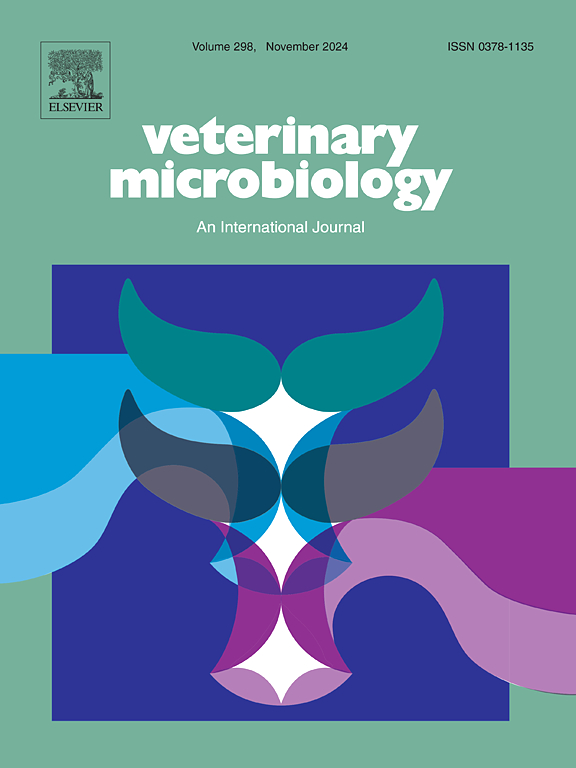Multi-locus sequence analysis of Anaplasma in the common warthog (Phacochoerus africanus) from South Africa
IF 2.7
2区 农林科学
Q3 MICROBIOLOGY
引用次数: 0
Abstract
The prevalence and diversity of Anaplasma in common warthog (Phacochoerus africanus) was investigated using a multi-locus sequence analysis (MLSA) approach targeting the 16S rRNA, citrate synthase (gltA) and heat-shock operon (groESL) genes. PCR screening of 100 warthog samples from the Kruger National Park in South Africa with eight published assays identified 50 positive animals, all of which were initially identified with the 16S rRNA assay. In contrast, the gltA and six groESL assays recovered PCR-positivity rates of 2 % and 0 %-4 %, respectively. As optimisation did not improve Anaplasma detection rates, an alternative groESL assay targeting a 923 bp region was designed. This new assay detected 45 positive animals, all of which were positive with the 16S rRNA assay. Nucleotide sequencing of the three MLSA gene targets confirmed that 50 % (50/100) of warthogs were Anaplasma-positive. Juvenile warthogs displayed a significantly higher infection rate (15/18; 83.3 %) than adults (35/82; 42,68 %). Phylogenetic analyses of individual and concatenated gene datasets confirmed that the Anaplasma species in warthogs is closely related to the species detected in Ornithodoros soft ticks from Zambia. This, together with the high levels of nucleotide sequence identity (≥98.97 %), suggests the likely existence of a host-restricted cycle involving warthogs and the soft ticks that inhabit their burrows. Based on the distinctiveness and monophyly of the Anaplasma species in warthogs and Ornithodoros soft ticks, confirmed through genetic characterisation of three gene regions, we propose that Candidatus status be assigned and suggest “Candidatus Anaplasma ornithodorii”.
南非疣猪无原体多位点序列分析。
采用针对16S rRNA、柠檬酸合酶(gltA)和热休克操纵子(groESL)基因的多位点序列分析(MLSA)方法研究了非洲疣猪(Phacochoerus africanus)无原体的流行和多样性。对来自南非克鲁格国家公园的100只疣猪样本进行了PCR筛选,并发表了8项检测结果,发现50只疣猪呈阳性,所有这些疣猪最初都是用16S rRNA检测方法鉴定的。相比之下,gltA和6种groESL检测的pcr阳性率分别为2 %和0 %-4 %。由于优化并没有提高无原体的检出率,因此设计了针对923 bp区域的替代groESL检测。新方法检测到45只阳性动物,16S rRNA实验均为阳性。三个MLSA基因靶点的核苷酸测序证实50% %(50/100)疣猪为无原体阳性。幼疣猪的感染率(15/18;83.3 %)显著高于成年疣猪(35/82;42、68 %)。个体和串联基因数据的系统发育分析证实疣猪中的无原体物种与在赞比亚的Ornithodoros软蜱中检测到的物种密切相关。再加上高水平的核苷酸序列一致性(≥98.97 %),表明疣猪和居住在其洞穴中的软蜱可能存在宿主限制周期。基于疣猪和软蜱无原体物种的独特性和单一性,通过对三个基因区域的遗传特征鉴定,我们建议将候选虫定位为候选虫,并提出“候选虫无原体ornithodorii”。
本文章由计算机程序翻译,如有差异,请以英文原文为准。
求助全文
约1分钟内获得全文
求助全文
来源期刊

Veterinary microbiology
农林科学-兽医学
CiteScore
5.90
自引率
6.10%
发文量
221
审稿时长
52 days
期刊介绍:
Veterinary Microbiology is concerned with microbial (bacterial, fungal, viral) diseases of domesticated vertebrate animals (livestock, companion animals, fur-bearing animals, game, poultry, fish) that supply food, other useful products or companionship. In addition, Microbial diseases of wild animals living in captivity, or as members of the feral fauna will also be considered if the infections are of interest because of their interrelation with humans (zoonoses) and/or domestic animals. Studies of antimicrobial resistance are also included, provided that the results represent a substantial advance in knowledge. Authors are strongly encouraged to read - prior to submission - the Editorials (''Scope or cope'' and ''Scope or cope II'') published previously in the journal. The Editors reserve the right to suggest submission to another journal for those papers which they feel would be more appropriate for consideration by that journal.
Original research papers of high quality and novelty on aspects of control, host response, molecular biology, pathogenesis, prevention, and treatment of microbial diseases of animals are published. Papers dealing primarily with immunology, epidemiology, molecular biology and antiviral or microbial agents will only be considered if they demonstrate a clear impact on a disease. Papers focusing solely on diagnostic techniques (such as another PCR protocol or ELISA) will not be published - focus should be on a microorganism and not on a particular technique. Papers only reporting microbial sequences, transcriptomics data, or proteomics data will not be considered unless the results represent a substantial advance in knowledge.
Drug trial papers will be considered if they have general application or significance. Papers on the identification of microorganisms will also be considered, but detailed taxonomic studies do not fall within the scope of the journal. Case reports will not be published, unless they have general application or contain novel aspects. Papers of geographically limited interest, which repeat what had been established elsewhere will not be considered. The readership of the journal is global.
 求助内容:
求助内容: 应助结果提醒方式:
应助结果提醒方式:


